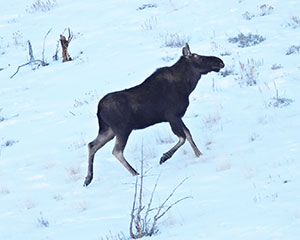
Contact Us
Institutional Communications
Bureau of Mines Building, Room 137
Laramie, WY 82071
Phone: (307) 766-2929
Email: cbaldwin@uwyo.edu
11 Adult Moose Spotted During UW Biodiversity Institute’s Winter Moose Day Weekend
Published February 16, 2024

This moose was spotted on the Sheep Mountain route Feb. 11, part of Winter Moose
Day weekend. Community scientists spotted 11 adult moose in the Snowy Range and Pole
Mountain areas, as well as Arlington, during the Feb. 10-11 event. Winter Moose Day
is coordinated, in part, by the University of Wyoming’s Biodiversity Institute. (Spencer
Hurt Photo)
For the 10th year in a row, community scientists glimpsed moose and collected data about their populations in two mountains ranges outside of Laramie during Winter Moose Day weekend.
Ninety-two surveyors, traveling by snowshoes or skis, trekked 26 routes in the Snowy Range and Pole Mountain areas, as well as Arlington, during the Feb. 10-11 event, which is coordinated, in part, by the University of Wyoming’s Biodiversity Institute.
Volunteers looked for moose or signs of moose. These can include tracks/hoofprints in snow, bed areas, scat droppings and browse on aspen and willows.
“Surveyors found 11 moose -- 12 if you count one that was spotted as a surveyor drove to their site,” says Mason Lee, senior project coordinator of the Biodiversity Institute. “It looks like it was all individual adult moose that were seen. No calves.”
The event drew 92 surveyors who made up 40 different survey groups. Sixteen of the 17 routes in the Pole Mountain area were surveyed; nine of 12 routes in the Snowy Range area were covered; and data was collected on the one route in the Arlington area, Lee says.
Lee adds that 11 of the 26 routes were surveyed by more than one group -- a practice that was first used during the 2022 Summer Moose Day. Each year, surveyors are typically a mix of some volunteers who participate each year as well as newcomers.
Volunteers collected what Lee refers to as “distance sampling data.” The data include how far volunteers were from the animals they spotted and what was their orientation versus the animals’ orientation.
Surveyors collected information on other mammals that were observed and other data that inform detectability, such as how these observations happened. These included: Was the animal moving? Was it still? Did it make a sound? Were the surveyors moving or stopped when they spotted the animals? Other mammals spotted by surveyors included rabbits, squirrels, deer and a fox.
Additionally, surveyors recorded what the snow coverage was like; how much of the area was in light versus in shadow; how many survey members were in each group; how many groups of people they saw while conducting the survey; and whether they saw any dogs on their survey routes.
The data gathered from Winter Moose Day will be shared with biologists at UW. These biologists use the data collected by community scientists to further their understanding of the population densities of local moose, their reproductive rates, their winter ranges and how these variables change over time.
More information will be learned after Dave Christianson, an associate professor in the UW Department of Ecosystem Science and Management, and his graduate students analyze the Moose Day data as well as external factors that can affect moose counts, Lee says.
Both the winter and summer Moose Day events are geared toward increasing the public’s understanding of moose in the Laramie area -- and involving the public in asking and answering questions. These events are an extension of the original program, Moose Day, held by Nature Mapping Jackson Hole (NMJH) in Jackson each winter. NMJH is a citizen science program created by the Jackson Hole Wildlife Foundation.
“2024 marks our 10th year of Moose Day surveys. We are so grateful to all of the volunteers who have braved the elements over the years to gather data on our local moose populations,” Lee says. “We hope our community continues to be invested in Laramie’s moose and beyond as our Moose Day program looks forward to the next 10 years.”
The UW Biodiversity Institute fosters conservation of biodiversity through scientific discovery, creative dissemination, education and public engagement. In this setting, scientists, citizens, students and educators come together to share a wealth of perspectives on the study and appreciation of biodiversity -- from microbes to poetry and ecosystems to economics. Learn more at www.wyomingbiodiversity.org.
Contact Us
Institutional Communications
Bureau of Mines Building, Room 137
Laramie, WY 82071
Phone: (307) 766-2929
Email: cbaldwin@uwyo.edu
